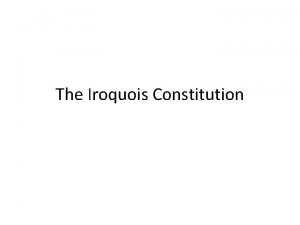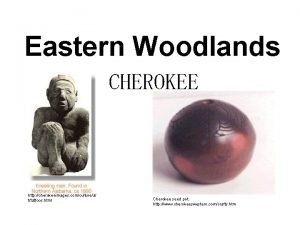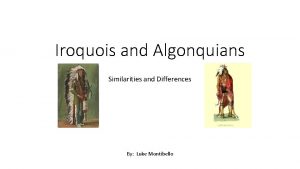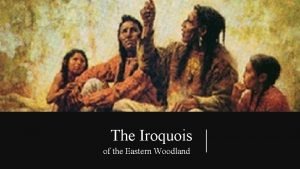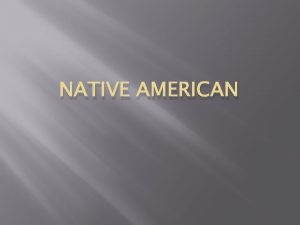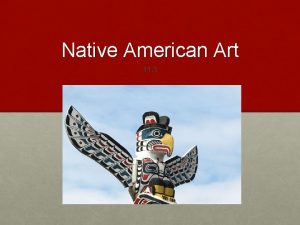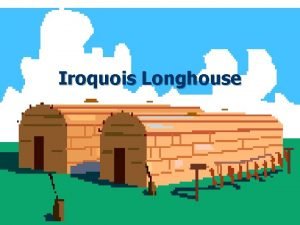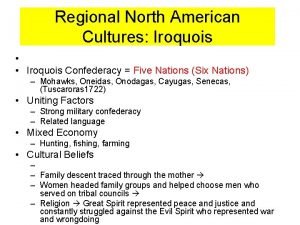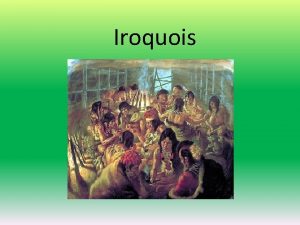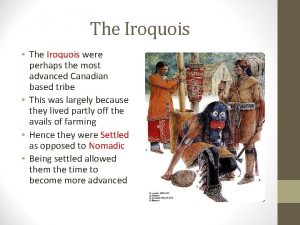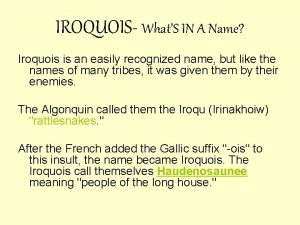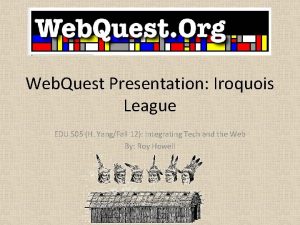Iroquois Culture FORMATION OF THE LEAGUE Dekanawida 1








- Slides: 8

Iroquois Culture FORMATION OF THE LEAGUE: Dekanawida 1. In the 1500’s, Dekanawida and Hiawatha wanted to end warfare. They tried to get tribes in New York to join together. “Peacemaker” 2. In 1570, 5 nations joined to promote peace and cooperation, and end warfare. 3. The 5 nations were the Mohawk, Oneida, Onondaga, Cayuga, and Seneca. Adodarhoh 4. The Tuscarora joined in the early 1700’s. Became known as the “ 6 Nations. ” 5. Iroquois called themselves the Haudenosaunee: “People of the Longhouse. ” 6. Iroquois: Name given to group of Indians in New York by the French during the 1600 -1700’s. 7. They were called the “Iroquois League, ” or Iroquois Confederacy. Hiawatha

2. LOCATION: 1. They lived in the present day state of New York along the Mohawk River, Great Lakes, and Finger Lakes. 1 2 4 3 5 Fulton County 6 Tuscarora

3. GOVERNMENT: 1. The Iroquois Confederacy was created by Dekanawida and Hiawatha. 2. The main purpose of the league was to bring about peace and stop the fighting among themselves. 3. The Iroquois created a system of law to govern the league called the Great Law of Peace. Iroquois flag Wampum belt

Iroquois government was a representative government in which the sachems represented the people Representative Government: system of government where voters elect representatives to make laws for them.

1. Iroquois depended on environment for all they needed. They only took what they needed. They did not waste any resources. 2. Iroquois did not own land. Used what they needed. They shared land with others. 3. Women controlled the village and the farm land around the village. 4. When the resources of an area were used up, the village moved. 5. Villages moved every 10 -20 years. They moved because the soil wore out. They needed to find fertile soil for farming. Palisade

E. ROLE OF IROQUOIS MEN: 1. Sachems: Men served as sachems. 3. Hunters: Men hunted and fished to provide food for the family and village. F. ROLE OF IROQUOIS WOMEN: 1. Farming & Gathering Food: Women grew corn, beans, and squash and gathered food from the environment. 2. Warriors: Men were warriors. They protected the village and league against enemies. 2. Picking Chiefs: Women picked and removed the sachems. 3. Food Preparation: Women prepared meats and other food for the people to eat. 4. Merchants/Traders: Men went to other villages and tribes to trade. They traded with Europeans when they arrived. Mortar and pestle for grinding corn and other things. 5. Cleared Land: Men cleared the land in order to build the village and farm. Drying fish and animal meat over smoke helped to preserve it so it would last longer. 4. Making Clothes: Women took animal skins (deer) and made clothing, shoes, blankets, and coats. 5. Raising Children: 6. Builders: Men built the tools and weapons that they used. Before the Europeans arrived, they used stone, wood, and bone for tools and weapons. After the Europeans arrived, they began using metal weapons and tools. 6. Make Tools: Women made the tools that they needed to do their jobs of farming, gathering, and cooking. They made pots, baskets, spoons, bowls from wood, bark, stone, and clay. 8

I. IROQUOIS RELATIONSHIP WITH THE LAND: WOOD: Used to make homes, tools, canoes, baskets, weapons, spoons, snowshoes. Natural Resources: Things found in nature that can be used to make objects used by humans. ANIMALS: Meat for food, skins for clothes, bones for tools and weapons. STONE: Used to make axes, hammers, arrow heads, knives SHELLS: Used to make Wampum Belts CLAY: Used for making pots, bowls, pipes, and toys

IROQUOIS VILLAGES: Villages were located by fresh water, wood, and fertile soil for farming. Built on high ground for protection Stockade or Palisade River or stream Fields for crops Canoes for travel
